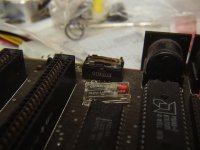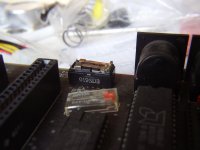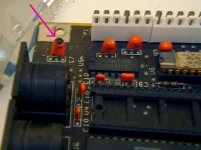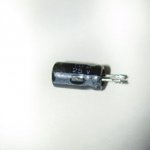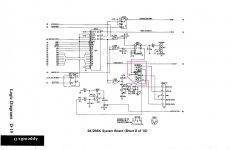Hello and welcome back, fellow vintage computerists! ;-)
First, thanks again for all your help so far. Now, to business:
It is getting "exciting" over here, because I was emboldened enough to finally return to the electronics part, having put the nuts and bolts, and dust and grime part on the back burner, after what felt like sufficient de-dusting and surface cleaning to try for "proof of life".
(I'll return to the de-rusting later. If what follows should properly go into a new thread, please tell me.)
So yeah, I tried a full-on power-up test yesterday.
It did not go well.
There was a spark, crack and smoke, which seemed to emerge from the relay (marked 2 in the above mainboard picture), which in fairness had still looked a bit on the corroded side before the test. Note to self: For fast unplugging, NEMA/Schuko may actually be preferable to BS 1363, which otherwise is of course
superior in damn near every way.
So, with the relay firmly in my cross-hairs, I took out my magnifying glass and found that there seemed to be quite a bit of copper "rust"
(technically copper corrosion or patina, I guess) inside the thing, and maybe even some residue. That's when I remembered that I'd had a MAJOR accident with a sugary fizzy drink bottle in the same room over a year ago. Could some of that stuff have gotten inside the case
and inside the actual relay? I hope not, but it looked and seemed possible. I took the following pictures:
(Yes, I've taken the cover off there.)
This is what it says on the relay:
Omron –
manufacturer
RU –
UL-recognized component mark
0193D3 (on the side) – probably a serial# (no relevant search engine hits)
and finally:
G2V-UA-006000 – this seems to be the actual designation of the component.
On the board, what seems to be a "K1" is partially visible.
K designates relays on PCBs, so that makes sense.
I searched for a replacement, but I can't seem to find anybody selling G2V-UA-006000 relays. They're probably long obsolete.
So I pondered my options.
But then–
...I suddenly discovered this:
Turns out the earlier stage appearance of Messrs. Snap, Crackle, and Pop had less to do with the DIPshit^W, sorry, DIP relay, and much more with a capricious tantalum capacitor throwing a critical terminal crisis tantrum and cracking its top.
The gentle reader is here kindly reminded of
these wise words:
Warning: NEVER use tantalum capacitors in a "high energy" circuit where voltage can EVER exceed the voltage rating of the capacitor. Even the shortest spike (sub microsecond) can puncture the oxide layer and "away it goes". Almost as much fun as a LiIon battery!. –Russell McMahon
Indeed.
Indubitably.
Elementary, my dear Watson:
It appears that whatever happened to the Omron relay, —sugary pop or no sugary pop—, it certainly somehow ended up with enough internal corrosion to generate just the kind of
undesired arcing fit to cause another kind of pop; to wit: dispatch the
primus inter pares of the tantalum infantry to Valhalla, Wagner-style.
(Or maybe
Tchaikovsky-style. Pick your preference.)
I googled and "farnelled" and "mousered"
10-16 capacitors, and the component I killed seems to be a "tantalum capacitor, solid leaded, 10-16V, triple lead". That would mean it's 10µF, 16 Volt. However, on page D-21 of the IBM Technical Reference for the 5150, =one of the logic diagrams for the 64-256K mainboard, it says: "All caps are 8.2µF tantalum on this page", and many of the caps on that page are labelled "C7" in the diagram – the same designation as the one next to the "10-16 ➁"-labelled capacitors on my actual board. (There are several C7 caps on the board.)
Does the difference between 8.2µF and 10µF not matter? Am I correct in inferring that "10-16 ➁" means a 10µF 16V tantalum capacitor, or have I made a mistake? Anybody know what the "➁" stands for?
I have actually already ordered some 10µF 25V triple lead tantalum caps to replace the one I killed, but I would be loathe to **** up even harder, so that's why I'm still asking you lot, to make sure I
spike lee. Not that I'm categorically opposed to the idea of ****ing up, but let's face it, the Mogherinis and Mayers of this world are probably not too interested in nannying washouts like yours truly.
I then discovered I actually had a 10µF 25V capacitor floating around:
...but it's an electrolytic one, and the Interwebs tell me that replacing tantalum caps with elcos, even just for testing, is apparently a major no-no, because of parasitic effects. Or so I read.
Returning to the relay which probably also needs fixing, I further studied the IBM TechRef, and was able to identify
Rusty the Relay in there:
I have cleaned the relay as best I could without using any water/solvent. The green stuff is pretty much all gone. The way I see it, I have the following options:
- Trust that the "dry cleaning" of the relay is "good enough" to prevent further arcing, replace the blown C7 with the elco I've got here despite the warnings in the hope that it'll be good enough for a single proof of life test and try again. (This is probably a bad idea – or is it? Could I do further damage? Presumably the polarity matters too? How would I install the two-lead elco in there?)
- Again, trust the "dry cleaning", wait for the tantalum 10µF 25V caps to arrive, replace the blows C7 with one of them and try again.
- Use water/distilled water to wet-clean/water wash the relay or the entire board and let it dry for a few days, install a replacement C7, and try again. (Is there another solvent I should/could preferably try?)
- Unsolder the relay for separate, immersive cleaning, and act as above. Can I easily go wrong with the soldering there? I know some more modern PCBs have not just two layers with traces on both sides of the board, but may actually be multilayer, potentially complicating the way components are connected. Am I right in thinking that the 5150 board is simply double-sided, with unproblematic all-the-way-through THT vias?
- Find an original or compatible replacement for the G2V-UA-006000 – unsolder and replace. Is anyone able to help with that? Can anyone tell from the logic diagram exactly what kind of DIP relay I should order? Or does anyone know where to get the original? I can't even find a spec sheet for the G2V-UA-006000. The only places I could "find" G2V-UA-006000 relays online were SEO-spamming "vendors" trolling for business and requiring a 500 parts minimum order. Translation: These guys don't stock the G2V-UA-006000, but if someone were to actually order from them, they'd try to get someone in Shenzhen to fab the order; or they'll talk you into buying something else, either of which may or may not work in the 5150.
- Lose faith in this board and order a replacement. $$$
- Abandon ship and actually order a second 5150 CPU, which might even have a non-rusty case. Despite the work-reducing advantages, the wastefulness makes this my least preferred option. Also, $$$$$. Or £££££ or €€€€€, whichever the case may be, but definitely not ¢¢.
If anyone has any useful input/advice on what to do, what not to do, any help would be very gratefully appreciated.
